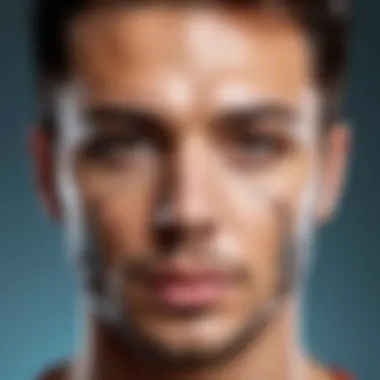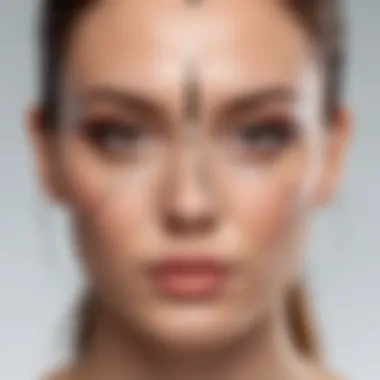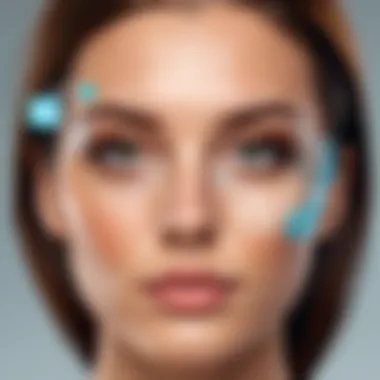Top Face Manipulation Apps for Photographers


Intro
In the vast landscape of photography, face manipulation apps have carved out a niche that appeals to a wide spectrum of users. These applications empower both novice photographers and seasoned experts to enhance their images, bringing creative visions to life in the digital realm. As photography continues to evolve with technology, understanding what these apps offer becomes paramount. This article aims to dissect the leading face manipulation applications, exploring their functionalities, ease of use, and distinct features. We will also address the ethical implications and privacy considerations that arise from using these tools in our digital interactions, allowing readers to navigate this space with a critical perspective.
Overview of the Technology
The technology behind face manipulation apps is multifaceted, marrying advanced algorithms with user-friendly interfaces. Many of these applications utilize artificial intelligence and machine learning to recognize facial features, facilitating accurate modifications and enhancements. This capability not only simplifies the editing process but also elevates the quality of the final output, making once complex tasks more accessible.
Key specifications
Most face manipulation apps offer a range of specifications that cater to varying levels of expertise. Common features include:
- Facial recognition: Enhanced accuracy in identifying and tracking facial features.
- Real-time editing: Immediate visualization of changes, allowing users to adjust on the fly.
- Custom filters and effects: Various artistic styles and enhancements to meet user preferences.
- Integration with other platforms: Ability to share edited photos directly to social media or cloud storage.
These specifications collectively enhance user experience, pushing the limits of creativity in photography.
Unique selling points
What distinguishes these apps in a crowded market? Here are some unique selling points:
- User interface: Intuitive design simplifies navigation, making them appealing to both amateurs and professionals.
- Advanced technology: Use of deep learning algorithms for superior image processing and accuracy.
- Customizability: Ability to tailor features according to user needs, ensuring a personalized editing experience.
These elements contribute to making each application stand out, aligning with the expectations of tech-savvy users.
Design and Build Quality
While the technological backbone is crucial, the physical and visual design of these applications also plays a significant role in user satisfaction. The aesthetic components of an app can greatly influence its usability.
Material used
Many face manipulation apps are designed to be lightweight and responsive. The layout often includes smooth lines and aesthetically pleasing interfaces that ensure a pleasant interaction. Minimal clutter enhances focus, allowing users to engage fully with their creative tasks without distractions.
Ergonomics and usability
The ergonomics of an app refer to its efficiency in performing tasks with minimal effort. Good usability is characterized by:
- Clear navigation: Clear icons and labels that guide users through the editing process.
- Efficient workflow: A streamlined process that reduces time spent on repetitive tasks.
- Responsive design: Adaptability across various devices ensures that users have a consistent experience regardless of the platform.
A well-designed app not only improves the editing process but also encourages creativity without unnecessary friction.
"The intersection of technology and creativity in photography apps opens up new avenues for artistic expression, setting the stage for innovative explorations."
In summary, identifying the best face manipulation apps requires an understanding of both the technological specifications and the practical, user-focused design elements. As you dive deeper into the features and considerations of each application, a more informed choice will emerge, aligning with your personal and professional goals.
Prologue to Face Manipulation Applications
Face manipulation applications have carved a notable niche in the world of digital photography, reflecting a profound evolution in the way we perceive and edit images. This section discusses the critical role these tools play in both personal and professional realms of photography. They are not just software; they embody a blend of creativity and technology. As users, we constantly seek ways to enhance visual narratives, and face manipulation allows for significant improvements in how images are perceived and understood.
Understanding Face Manipulation
Face manipulation refers to the digital enhancement or alteration of facial features in photographs. This includes tasks like beautifying, reshaping, and even placing different faces onto images. With advances in artificial intelligence and image processing technologies, these apps are becoming increasingly sophisticated. The ability to manipulate faces turns static images into effective tools for storytelling. Moreover, by understanding the technical jargon and functionalities of these applications, users can maximize the benefits they provide.
The landscape of face manipulation has also adapted to the needs of its users. Understanding optimal usage, such as incorporating subtle adjustments or dramatic edits, informs better visual outcomes. Furthermore, users must navigate through various options to find the tools that meet their individual needs, whether for personal memories or professional portfolios.


The Importance of Facial Editing in Today's Digital Culture
Facial editing has become indispensable in today’s digital culture. It significantly influences how we communicate visually. In a world dominated by social media platforms, individuals curate their online presence through images, and face manipulation apps play a crucial role in this process. They allow users to present themselves in the most favorable light. The need for aesthetic perfection can lead individuals to turn to these applications for assistance in achieving an idealized self-image.
Equally important is the professional realm. Photographers and marketers utilize face manipulation to create compelling visuals that capture attention in fleeting moments. Brands leverage these tools to enhance their marketing materials to maintain a competitive edge. In this context, facial editing is not just art; it can be strategic, aiming to evoke emotions and reactions.
"In a digital era where first impressions are often formed through visuals, the mastery of facial editing becomes not just a skill, but a necessity."
Thus, the relevance of face manipulation applications extends beyond mere aesthetics; they influence perception, identity, and even engagement within digital spaces. Understanding their features and importance lays the foundation for selecting the best apps suited for individual preferences and professional requirements.
Criteria for Selecting the Best App
The digital landscape is rich with options when it comes to face manipulation applications. However, not every app will meet the needs of every user. Understanding the criteria for selecting the best app is crucial to ensure optimal user satisfaction and performance. Here, we will evaluate specific elements, emphasizing the benefits and essential considerations that contribute to an informed decision.
User Interface and Experience Considerations
A well-designed user interface (UI) is vital for any face manipulation app. Users often seek a straightforward, intuitive experience. If an app is cluttered or counterintuitive, it can lead to frustration and ultimately result in abandonment. App aesthetics, layout, and navigation should facilitate a smooth workflow. Clear labeling and accessible settings enhance usability, making it easier for users to achieve desired results without a steep learning curve.
Factors like responsiveness and load times further impact user experience. A sluggish app can detract from the creativity and spontaneity often sought in photo editing. Aspects such as these make a significant difference in the overall satisfaction.
Functionality and Feature Set
The functionality of the app is perhaps the most critical aspect. Users need robust features that allow them to manipulate faces in various ways. Key features can include options like skin smoothing, blemish removal, or the ability to adjust facial proportions. Some applications may provide unique offerings such as beauty filters or advanced algorithms for placing faces seamlessly onto different backgrounds.
It is also crucial that these features work effectively. An app that promises high image quality but delivers reduced outputs is of little value. Therefore, users should assess whether the functionality aligns with their photography needs.
Price and Accessibility
When evaluating face manipulation applications, the cost is a primary consideration. Many apps offer a freemium model, allowing users to experience a subset of features before committing to purchase. However, other apps may require upfront payment or ongoing subscriptions. Users should weigh the price against the offered features and consider if they are worth the investment.
Accessibility also depends on the device compatibility and availability across platforms. An app that functions well on iOS but not on Android will limit its user base significantly. Thus, potential users need access to the application regardless of their preferred ecosystem.
"An app’s usability, features, and price can either enhance or inhibit creative expression. It is essential to choose wisely."
Top Applications for Face Manipulation
In the landscape of digital photography, face manipulation applications serve a dual purpose: enhancing images and providing creative outlets for users at all skill levels. These apps enable individuals to adjust facial features, alter expressions, and even merge faces with other images. This section delves deep into a selection of top applications that excel in face manipulation. By understanding their functionalities and unique features, users can select the app that truly aligns with their creative needs.
Application One: Overview and Features
The first app on the list is FaceApp, which has gained significant popularity due to its versatile editing features. It utilizes advanced neural network technology to produce realistic edits. With options to change hair color, apply filters, and even age or de-age a face, users have plenty of creative room for exploration. The app also supports background changes with various settings. Its user-friendly interface makes it accessible to beginners and experts alike.
Application Two: Overview and Features
Next, we explore Snapseed. Developed by Google, Snapseed is known for its extensive editing tools, including facial enhancement options. The app’s Portrait tool makes subtle adjustments to skin tones, contrast, and brightness on facial features. Its precision allows for targeted edits, making it a favored choice among photography enthusiasts. The capability to save and apply custom filters can lead to a consistent editing style across images.
Application Three: Overview and Features
YouCam Makeup focuses specifically on beauty and cosmetic adjustments for photographs. With a wide range of makeup options, users can apply virtual makeup, change skin tone, and enhance facial features easily. The live camera feature allows real-time editing, making it fun to see the immediate effects. It also offers a social integration feature, encouraging users to share their edited images directly to platforms such as Facebook and Instagram.
Application Four: Overview and Features
In the realm of face swap applications, Reface stands out for its impressive technology. Users can swap their faces with celebrities or characters seamlessly. The app employs sophisticated algorithms to map facial features accurately, providing a realistic end result. It also offers a variety of hilarious GIFs and videos that can be easily shared. The app’s engaging content makes it attractive to a younger audience.


Application Five: Overview and Features
Lastly, PicsArt is an all-in-one editing app that includes a suite of face manipulation tools. Its features range from basic adjustments to creative overlays and filters. The app includes face reshaping tools, which can modify facial dimensions and features. The community aspect of PicsArt allows users to participate in challenges while showcasing their creations. Its versatility makes it a top pick for those looking to explore a multitude of editing possibilities.
Each of these applications offers unique features, catering to different needs in photo editing and face manipulation. Users can choose based on specific functionalities that resonate with their creative expression.
Technical Aspects of Face Integration
Understanding the technical aspects of face integration in photography applications is crucial for maximizing the effectiveness of these tools. These elements help users achieve realistic and polished results in their editing endeavors. Emphasizing technological proficiency, this section explores the core components that define the landscape of face manipulation tools.
Artificial Intelligence in Face Editing Apps
Artificial Intelligence (AI) plays a transformative role in face editing applications. Many modern apps utilize advanced algorithms to detect faces, analyze features, and make real-time adjustments. This enhances the user experience by allowing for seamless integration of faces into images.
The automation of intricate tasks, such as skin retouching or background alignment, can save significant time while maintaining high quality. AI-driven features can also suggest edits based on user preferences or historical data. This interaction fosters a personalized approach to photo editing.
Image Quality and Resolutions
Image quality is a pivotal factor in face manipulation. High-resolution images ensure clear details, which are especially important when merging different elements. Many face manipulation apps support various resolutions, catering to both mobile and desktop environments. This flexibility allows users to choose settings that align with their intended output, whether for social media or print.
Additionally, understanding compression methods and formats can be valuable. Lossy formats like JPEG make smaller files but often sacrifice some quality. On the other hand, formats like PNG preserve quality better but could result in larger files. Users should find a balance that meets their needs regarding clarity and storage.
Editing Tools and Options
The range of editing tools is another critical component of face manipulation applications. Users should look for available options that fit their creative needs. Key features often include:
- Retouching Tools: These help in skin smoothing, blemish removal, and enhancing facial features.
- Custom Filters: Many apps come equipped with preset filters or allow users to create custom ones for unique looks.
- Layering Capabilities: This feature enables users to work with multiple elements in separate layers, providing more control over the final image.
- Background Editing: Adjusting or replacing backgrounds can dramatically change the context of a photo.
Ethical Considerations in Face Manipulation
The advancement of face manipulation technology in photography has opened up vast possibilities. However, the rise of these applications brings forth a set of ethical considerations that are crucial for users and developers alike. Understanding these implications is vital to ensuring responsible usage and fostering trust in digital media.
Privacy Concerns
Privacy is a focal point in the discourse surrounding face manipulation apps. Users often upload their images, sometimes without understanding how these are stored or utilized. The potential for misuse of these images raises valid concerns. With many apps utilizing cloud solutions, it is essential to scrutinize data handling practices. Users should look for transparency in terms of how their information is used, shared, or sold. Furthermore, applications need robust security measures against unauthorized access. If a user's photo is manipulated and distributed without their consent, the ramifications can be serious and widespread.
Misrepresentation and Its Implications
Misrepresentation is another critical issue tied to face manipulation. The technology allows for extreme modification, which can lead to altered perceptions of identity and self-image. Users might present images that do not reflect reality, fostering unrealistic standards of beauty or persona. Those using these images for marketing or social media might deceive audiences, leading to distrust and ethical dilemmas. This false representation can have broader social implications, contributing to mental health issues related to body image. It is essential for users to recognize the implications of what they publish online and to consider authenticity versus modified presentations.
Regulatory Perspectives on Privacy in Technology
As the technology sector evolves, regulations lag behind. Different regions have varying laws regarding privacy and online content. For instance, regulations like the General Data Protection Regulation (GDPR) in Europe aim to protect personal data, but many users remain unaware of their rights. This creates a necessity for a consistent framework addressing face manipulation. Developers of these applications need to be cognizant of these regulations, ensuring compliance to promote safe practices among users. The challenge lies in striking a balance between innovation and regulation while maintaining ethical standards in face manipulation technology.
"The increase in technology should be met with equally robust regulatory measures to protect users."
In summary, exploring ethical considerations in face manipulation is paramount. As users navigate the rich landscape of applications available, staying informed about privacy, representation, and regulation will foster a healthier interaction with technology.
User Experience: Comparative Insights
User experience is fundamental when choosing face manipulation apps. It encompasses how users interact with the software and how those interactions influence their overall satisfaction. A well-designed user experience can significantly enhance a user's ability to execute complex tasks efficiently. When considering these applications, the design layout, navigation flow, and intuitiveness play a crucial role.
Having an effective user interface not only improves engagement but also directly impacts functionality. Users are likely to be more productive when the app layout is clear and straightforward, allowing them to focus on creative aspects instead of navigating cumbersome settings.


It is essential to compare feedback across various platforms to identify patterns and preferences. This comparative analysis provides insight into user satisfaction regarding different features and functionalities. Additionally, it highlights common frustrations that may arise due to varying design philosophies utilized by different developers.
"User feedback is an invaluable indicator of app performance and can guide future updates and enhancements."
Reviewing User Feedback Across Different Platforms
User feedback varies notably across platforms, influencing perceptions and experiences. For instance, applications like FaceApp and Photoshop Express receive a considerable amount of user reviews on app stores and user forums, including Reddit.
Analyzing feedback reveals several key factors:
- Features: Users often highlight specific functionalities that enhance their creative process. For example, the ability to layer images or utilize filters can be crucial for many.
- Usability: Ease of use is frequently mentioned. Applications with a steep learning curve may deter users from fully exploiting their capabilities.
- Performance: Users note how well the app operates across different devices. Issues with lag or crashes can affect user experience negatively.
This information can reveal trends not easily captured through official marketing materials, presenting a more transparent view of the app's strengths and weaknesses.
Performance Benchmarking of Top Apps
Performance benchmarking is crucial when evaluating face manipulation applications. It involves measuring different software’s capabilities in specific areas such as speed, efficiency, and output quality.
When conducting benchmarking, consider the following aspects:
- Load Times: How quickly does the app open and load images? Users prefer applications that minimize wait times.
- Processing Speed: Evaluate how efficient each app is in handling edits. Fast processing times can enhance user satisfaction, particularly for those handling large files.
- Output Quality: Assess the final product's quality after manipulation. High-resolution outputs are vital in professional photography.
Benchmarking results can be shared as a comparative chart to visualize the differences in performance among popular apps. This analysis provides users with a solid foundation to make informed decisions based on their needs and preferences.
Future Trends in Face Manipulation Technology
As the digital landscape continues to evolve, face manipulation technology is reshaping photography. With advancements in software and hardware, it is crucial to understand how these trends will influence both creators and consumers. The relevance of discussing future trends lies in the necessity for users to stay informed and adapt to the rapid changes in technology. New innovations will affect usability, enhance creative potential, and introduce ethical considerations within the sphere of photography.
Innovations on the Horizon
The future of face manipulation applications promises several innovations that may redefine the user experience. Key areas of improvement include:
- Real-time Editing: Applications are increasingly able to perform edits in real-time. This allows users to adjust facial features while capturing an image. This technology relies on high-performance algorithms and processing power.
- Advanced AI Integration: Artificial intelligence is becoming more sophisticated. Future apps will likely leverage machine learning to automate editing decisions, improving accuracy and efficiency in face manipulation.
- Augmented Reality Features: The incorporation of augmented reality (AR) can enhance face manipulation by overlaying digital effects directly onto the user’s view. This can help users visualize edits before applying them.
- Voice Command Functionality: As voice recognition technology improves, users may be able to manipulate images hands-free. This is ideal for creators who manage multiple tasks like shooting and editing simultaneously.
These anticipated innovations highlight the potential for a more interactive, user-centered editing process. As developers focus on creating intuitive interfaces, the barrier to entry for advanced editing techniques will decrease, inviting a broader audience into the field of face manipulation.
Potential Impact of Emerging Technologies
Emerging technologies will significantly impact the landscape of face manipulation. These influences can be explored through various dimensions:
- Increased Accessibility: With the rise of cloud computing, functionality is shifting toward mobile platforms. This means powerful editing tools could become widely available on personal devices.
- Ethical Challenges: As manipulation becomes easier and more realistic, ethical concerns will rise. Users must address the implications of altered images, including issues of authenticity and potential misrepresentation.
- Enhanced Collaboration: As we move forward, face manipulation technology could enable real-time collaboration among users. Teams can work on projects from different locations, allowing inputs from multiple creators seamlessly.
- Consumer Expectations: As technology progresses, consumers will expect more from face manipulation apps. This will compel developers to innovate continuously, staying competitive in the market.
The End and Recommendations
In the digital age, where image editing has become commonplace, the ability to manipulate faces within photographs plays a crucial role. As this article explores, the right app can make significant impact on how users enhance their photos. Conclusion and recommendations are essential in guiding users through their choices after evaluating the various apps mentioned. As users consider which application can best serve their needs, the benefits and considerations of each become increasingly clear.
Summarizing Key Findings
Throughout this article, we discussed key features and aspects of face manipulation apps that are crucial for selecting the right one. Here are the main takeaways:
- User Experience: An intuitive user interface allows users to navigate complex features without frustration.
- Functionality: Diverse tools, such as skin smoothing and face reshaping, cater to different needs and preferences.
- Pricing and Accessibility: Some apps offer premium features for a fee, while others maintain a good range of free options.
- Ethical Considerations: Users must be aware of privacy issues and the potential for misrepresentation when editing faces.
- Future Trends: Innovations in artificial intelligence are likely to lead to even more sophisticated editing capabilities in the near future.
Attention to these factors helps users gain a clear understanding of what to expect from these applications.
Recommendations for Users
Given the diverse range of applications available, specific recommendations can help users make informed choices. Consider the following:
- Identify Your Needs: Before selecting an app, clarify what features are most important to you. Are you interested in simple touch-ups or more advanced editing?
- Test Multiple Apps: Many applications offer trial versions. Use these opportunities to explore different interfaces and capabilities.
- Stay Updated on Trends: Regularly check for updates and new applications, as technology in face manipulation evolves rapidly.
- Be Ethical: Always consider the ethical implications of editing your images, especially when sharing online. Protect your privacy and respect the privacy of others.
- Join Online Communities: Platforms like Reddit can offer valuable user insights and experiences regarding different apps.
By following these recommendations, users can not only enhance their photography skills but also engage with technology in a responsible and informed manner.







